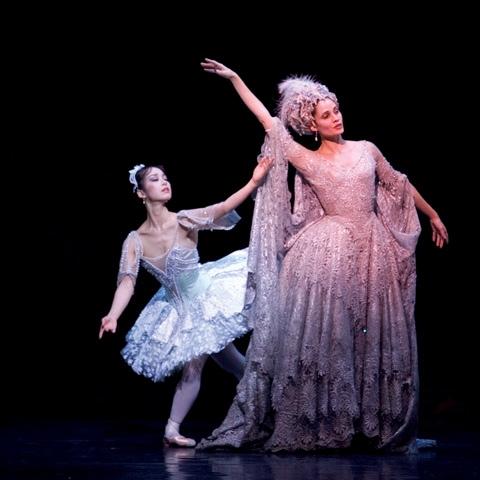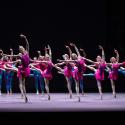Good dancing - never mind great dancing - calls for an investment of imagination in every point of the foot, every raise of the arm. Why otherwise do the constant drill of turning out the leg, stretching the instep, taking fifth position, if the performer does not find something to stimulate them to make it personal, to dream it, to claim it for their own nuance? Does the violinist play Schubert thinking that it is enough just to get the notes right? Ballet is not just a gymnastic drill - it is a wildly esoteric performance art that surely no one seriously wants to pursue unless they feel its allure, its off-the-wall strangeness, its unique poetry of the body.
Ah well, we spectators, eh? Always that gap between what we want to see on stage and what we are given. A gap of aspiration, a gap of hope, maybe a hope too far. Well, Birmingham Royal Ballet have certainly got the finest production of Sleeping Beauty that I may ever have seen in Britain, and they certainly have some of the most luscious ballet music-making. And they have a magnificent text for the ballet, produced by their former director Peter Wright from the Petipa original, and calling for stylishness and expressiveness of utmost aristocracy - a style long since gone out of style in this company, which copes far more happily with classless contemporary ballet.
Far superior to any of the three Royal Ballet productions of the past two decades, this 1984 production by Peter Wright and Philip Prowse for the company predecessor, Sadler’s Wells Royal Ballet, is of deeply alluring opulence, black, gold, dark blood, marble and ormolu - with wigs and tiaras atop brocades that never look like curtains and always like the couture livery of the finest court in Europe. Prowse’s vision, lit as if with gaslight by Mark Jonathan, embodies a full-hearted ambition to dazzle and impress in this most dazzling and majestic of ballets. Candelabras are held aloft by bewigged flunkies, Aurora sleeps at the foot of a golden obelisk, the Lilac Fairy is a glorious full-skirted opaline goddess with a baroquely plumed and jewelled turban. While Oliver Messel’s 1946 Royal Ballet sets (part-recreated in Covent Garden’s current version) summon up an arcadian outdoors, Prowse’s enclose the glistening characters in a richly solid, veined and gilded interior, like a gorgeous Fabergé egg held in its ornate golden cradle.
So expert is the build with the music as Wright marshals the courtiers on at the beginning that when the King and Queen finally do appear you feel like applauding already. This really is total theatre of the grandeur that great ballet demands. Carabosse, the wicked witch, is borne eyecatchingly onstage standing high on a black chariot carried on her minions' shoulders. The fairies bear generous gifts, a harp, a jewelled tree, and their soft Russian tutus appear to be showered with gold leaf. Catalabutte metamorphoses from a big-wigged figure of overdressed fun in the Prologue to a priestly attendant with the Sun King’s emblem blazing from his robe in Act 3.
Luxury, sense of occasion, grand style, everywhere you look your eye is ravished. And last night the ear was ravished too with the zippy, excited conducting of Paul Murphy - infectiously feeling the score’s pulse, rather than holding it back for dancers - and the heavenly playing of Robert Gibbs, leader of the Royal Ballet Sinfonia, who is for my money one of the finest violinists to be heard anywhere, with a Perlmanesque fullness of tone. Wright keeps the usually cut violin entr’acte for him, but places it after the Prince kisses Aurora awake, thus enabling his one big new departure from the text, a fluid balletic dialogue for the lovers to get to know each other while the violin soars on its wings of desire.
Much, much, therefore to relish, and certainly many incidental character performances too to enjoy last night - David Morse’s intensely self-critical Catalabutte, mortified at his omission of Carabosse from the guest-list, and Andrea Tredinnick’s majestically gracious, reassuring walking part as the Lilac Fairy, absolutely convincing you that her magic was superior to that of the spitfire Marion Tait as Carabosse. Robert Parker, BRB’s leading man, took an unaccustomed subsidiary role as the Fourth Prince in the Rose Adage, no doubt to offer stability and safe hands to the Aurora of the night, Nao Sakuma.
Sakuma, BRB’s queen bee, was shaky in her balances last night, a symptom of the limitations of her dancing. Characteristically, she danced well inside her capacity - emitting a sense I too often get from her of not risking to inquire into what she was dancing. She is compact, competent enough, but doesn’t pick her feet up much, or yield sweetly in the body, or seem to sense the stiff brokenness of her wrists when she frames an oval with her arms - dewy little nuances and sensed emendments from her own imagination would give more interest and indeed stability to her competence. Is it BRB training? Their women have sporty, two-dimensionally drawn arms, matter-of-factly hingeing from the shoulder, not flowing from deep in the spine and soul, and feet are functional blunt instruments to raise themselves on point, not silken feathers to stroke the earth with illusions of hovering. These are some reasons why their fairies were unfairy-like last night.
The Prince, Iain Mackay, is tall, dark and well-proportioned, and partnered his rather unresponsive Aurora with romantic solicitude, though he ran out of style and steam in those final killer variations. Such shortcomings in dancers are thrown into unforgiving perspective just now in this spring season of outstanding dance riches in London - Mark Morris’s masterly company last week, the already scintillating young Sergei Polunin of the Royal Ballet, and this Friday the retiring performance at the Royal Ballet of Miyako Yoshida, once queen of BRB. Performers like these demonstrate that good (let alone great) dancers don’t just do steps, they know that steps are only clods of earth from which to fashion thoughts, dreams, hopes, images, propositions, teases, other worlds. Just clods of earth otherwise.
- Birmingham Royal Ballet perform The Sleeping Beauty at the Coliseum until Saturday as part of the Spring Dance Coliseum season.
- Check out what's on at Birmingham Royal Ballet this season
- Miyako Yoshida's final performance is in Ashton's Cinderella at Covent Garden on Friday














Add comment